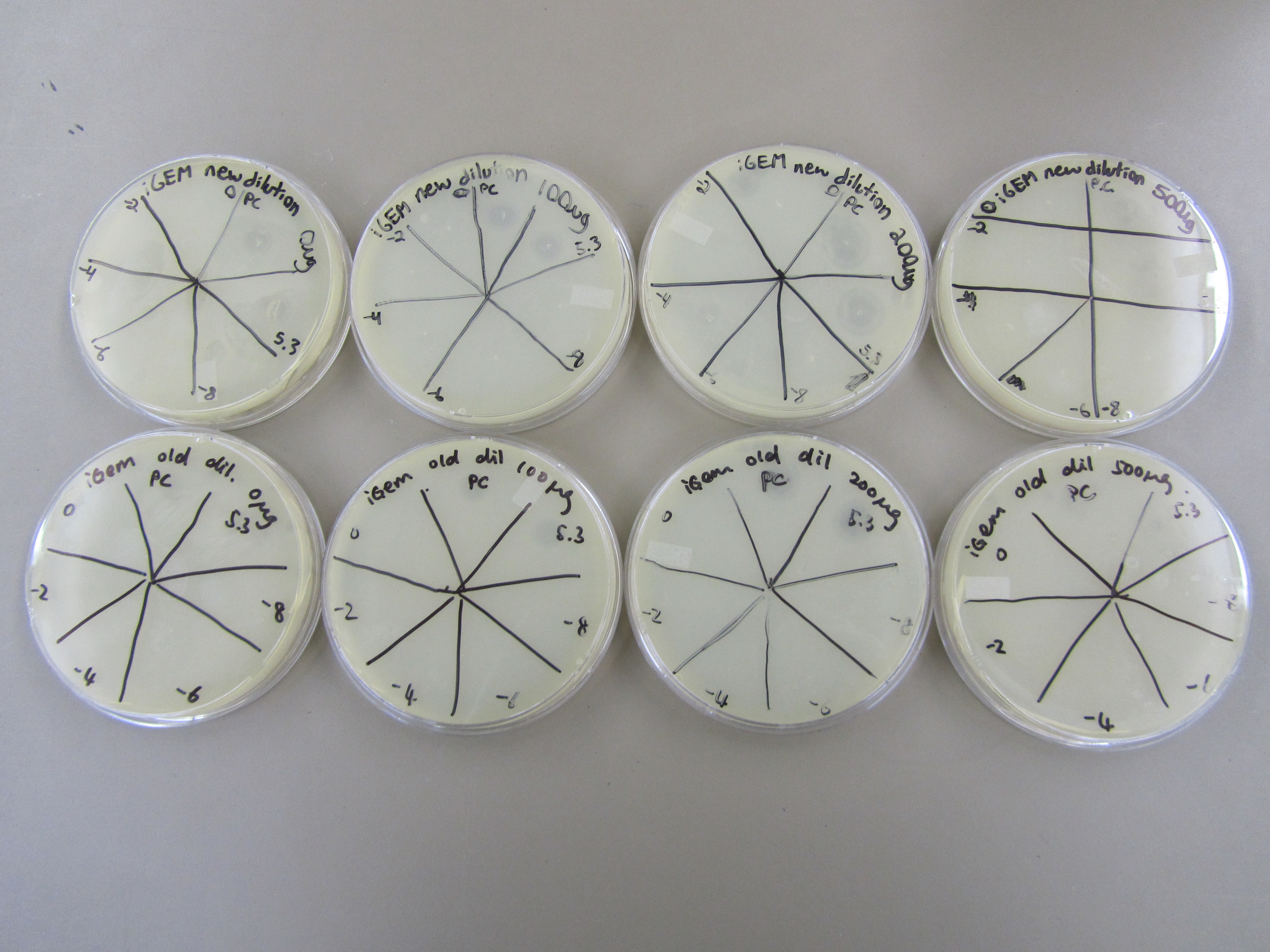|
- Small Phage
- March-April
- May-June
- July-August
- September-October
|
6.27 Mutagen Concentration Test - Third Protocol
I) Purpose
- To test the third protocol for applying 5-bromodeoxyuridine and inducing mutation.
II) Expected Outcome
- - A decrease in phage viability with increasing mutagen concentration.
- - A few random mutations that produces smaller phage and consequently larger plaques during selection with x8 agar.
III) Reagents Used
- 5-bromodeoxyuridine stock in freezer labeled T7 (10mg/mL); 50mL of M9+ prepared by the large phage group; BL21 overnight; 5.3 phage stock; x8 top agar; uracil solution (2.5mg/mL); adenine solution (5mg/mL).
IV) Procedure
1) Applying the mutagen (6.12)
- - From 5.13 Determining E coli concentration with spectrophotometer, we know that the concentration of E coli BL21 in a liquid overnight culture is about 3.12E8 cell/mL. But we need to resuspend it in M9+ medium.
- - To make the M9+ suspension medium supplemented with the appropriate amount of uracil and adenine, 200uL of adenine solution and 400uL of uracil was add 50mL of M9+.
- - Label 5 centrifuge tubes (15mL) 0, 100, 200, 500, and C (control). To each of these test tubes, add 10 mL of E coli overnight. Cells were then pelleted via centrifuge at 4000rpm for 10min at 7 Celsius. Supernatant was taken out using pipets and discarded. E coli was then resuspended in 10mL M9+ supplemented with uracil and adenine.
- - To four centrifuge tubes, add 0, 100, 200, and 500 uL of 5-bromodeoxyuridine (add nothing to C). The volume of the mutagen should correspond to the label on the test tube. Because 5-bromodeoxyuridine stock is a 10mg/mL aqueous solution, the final mutagen concentration in the five test tubes will be 0, 100, 200, and 500 ug/mL.
- - Let the bacterial suspension incubate with mutagen for approximately 1h 30min.
- - 30uL of 5.3 phage stock was added to each centrifuge tube (add nothing to C). From 5.15 Titer Test on 5.3 T7 new Phage Stock, we know that 5.3 phage stock has 7E8 particles/20uL. Thus, to each of the test tubes, we are adding approximately 1.2E9 particles.
- - Incubate phage on shaker at 37C until clearage: 22hours.
- - Liquid culture from the four test (excluding C) tubes is then centrifuged at 4000 rpm for 10 minutes to pellet cell debris. Supernatant containing phage particles is removed and 1mL of chloroform is added to destroy any remaining E coli cells.
- - The stock solutions are now stored in 4 Celsius.
2) Titer to Determine Phage Concentration 1 (6.28)
- - For each mutagenesis, specifically 0, 100, 200, and 500ug/mL, 1:100 dilution series were performed to generate 0, -2, -4, -6, and -8 dilutions.
- - For each dilution, a test tube was assigned to it. To each test tube, 0.75mL of BL21 liquid culture overnight was added and then transfected with 30uL of phage dilution. After 20 minutes of incubation, 7mL of x8 agar was added to each test tube and the content was then plated.
- Plates were incubated upside down for 72 hours.
3) Titer to Determine Phage Concentration 2 (7.2)
- Same process for as Titer to Determine Phage Concentration 1, but plates were incubated for only 24 hours.
4) Spot test to confirm phage viability (7.3)
- Spot test was performed using procedures similar that those in 4.25 T7 phage viability test]
- Phage solutions spotted include 2 dilution series from mutagensis result (one created on 6.28 and one newly created from stock). Two positive controls were used: 5.3 stock (this is what we used for mutagenesis) and mutagenized stock from 6.12 Mutagen Concentration Test - Second Protocol.
V) Results
1) Applying the mutagen
- - No clearage was seen after 22 hours. Following steps were carried regardless.
2) Titer to determine phage concentration
- - The plates were left in for too long so the bacteria overtook the plaques that formed; no viable data.
3) Titer to Determine Phage Concentration 2
- - There was one plaque on the "500ug -2" plate and 11 plaques on the "200ug -8" plate. All other plates had no plaques. We are not sure why this is.
4) Spot test to confirm phage viability
- - Both of the two positive controls formed plaques on all of the plates. The only other plaque was on 200ug, new dil, 0.
- - This confirms our suspicion that phage death occurred because it was incubated for too long with mutagen.
VI) Conclusion
- Something went seriously wrong with this set of mutagenesis. None of the phage survived. Not even those in the control test tube, with no added mutagen. We weren't able to identify the source of phage death because our phage stock remained viable in the fridge. We have thus decided to repeat this experiment with shorter incubation time to rule out the possibility that it is the longer incubation time that killed the phage.
|
 "
"
